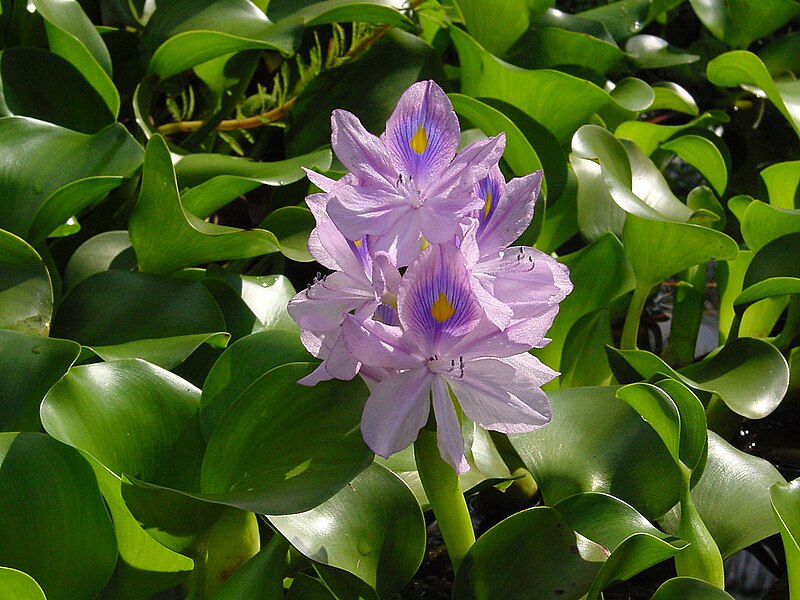Mohammed Mabrouk, a farmer in Matai, Minya governorate, struggled to secure enough water for his soy crop. The water hyacinths that have long plagued the nearby Fataika canal are becoming more of a threat to his livelihood with each passing year.
“It’s become too much for us to handle, and it’s taking up most of the canal’s water,” he tells Egyptian Streets. “It’s becoming more widespread, and this year, it’s become too much for us to handle.”
Mabrouk, like the hundreds of farmers in neighboring villages, has been unable to control the water hyacinths that are exacerbating the dwindling water supply to the essential crops of corn, soy, and grapes that the region produces.
Native to the Amazon River in South America, water hyacinths have posed a significant threat to river ecosystems in the Middle East and North Africa since their introduction in Egypt as ornamental plants in the 1880s, and while the exact record is not clear on who first brought it to Egypt, one tale suggests that Khedive Tawfiq was the one who imported it to Egypt because of his fondness for beautiful plants.
Known locally as Ward Al-Nil (flowers of the Nile), they swiftly expanded into the country’s agricultural and drainage canals, thriving in shallow waters conducive to their growth.
Despite their beauty, these plants are notorious for their high-water consumption rates.
In Egypt, water hyacinths contribute to the loss of approximately 3.5 billion cubic meters of water each year through evapotranspiration, which amounts to roughly four percent of the country’s annual share of Nile waters.
Their rapid proliferation can lead to localized water shortages, causing the loss of thousands of acres of arable land wherever they spread over the decades.
Beyond water consumption, water hyacinths have significant implications for biodiversity in Egypt’s Nile Delta, home to crucial wetlands like Lake Burullus and Lake Manzallah.
According to Hassan Abdel Shafy, professor of pollution control at the National Research Center, water hyacinths are notoriously difficult to eradicate once established as they propagate through both seeds and broken stems.Their seeds can remain viable in the soil for up to 20 years, germinating whenever conditions are favorable, such as in moist soil or shallow waters.
In Egypt’s Nile Delta, farmers and authorities face similar challenges. Despite annual dredging campaigns aimed at removing the plants, water hyacinths continue to colonize thousands of drainage and irrigation canals, posing persistent environmental and logistical problems to millions of farmers around Egypt.
Over the decades, various methods have been attempted to eradicate water hyacinths, but most have not achieved the desired success due to their low efficiency, high cost, or significant environmental impacts.
Many biological methods, for instance, often exhibit low efficacy and can disrupt ecosystems. Additionally, anaerobic decomposition of water hyacinth residues in water channels releases greenhouse gasses and depletes dissolved oxygen, leading to the death of aquatic organisms. Over time, many biological agents may become neutral towards water hyacinths and may even affect other economically important plants.
Chemical control methods have raised significant environmental concerns due to their potential massive ecological damage, including harm to other aquatic plants, herbs, and fish. Moreover, disposing of water lettuce residues after their demise in waterways remains a persistent challenge.
As for mechanical methods, traditional equipment such as weed harvesters have not yet demonstrated expected success on a national scale. This is largely due to their inefficient use of energy resources and limited capacity, given the vast amounts of water the plant contains.
Similar equipment cannot effectively operate in many shallow or narrow water channels, as heavy machinery cannot maneuver such locations properly. Additionally, disposing of water hyacinth residues remains one of the greatest challenges for mechanical control methods, often resulting in significant environmental and logistical issues when piled along watercourse banks.
Despite the challenges, Abdel Shafy remains optimistic about finding solutions.
“Interestingly, water hyacinths have some beneficial properties,” he explains. “They can absorb heavy metals and pollutants from water, which could be utilized in bioremediation processes.”
He adds that these plants can be used as animal feed or for producing biogas through anaerobic digestion, which converts organic material into a renewable energy source.
“If managed correctly, water hyacinths could be of great economic benefit, but It’s essential to approach the issue scientifically rather than sensationally,” he states.







Comments (0)